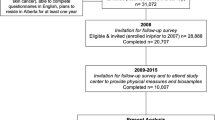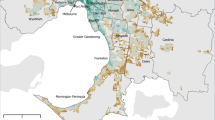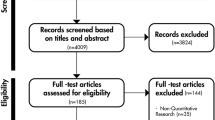Abstract
Although there is growing consensus that population-level improvements in cardiovascular health depend upon environments that promote healthy lifestyles, evidence to support large-scale investments in neighborhood greenery to tackle obesity is inconsistent and has not focused on adults in middle-to-old age who experience the greatest burden of chronic health problems. Multilevel linear and multinomial logit regression models were fitted to investigate association between body mass index and an objective measure of green space in a sample of 246 920 Australian adults aged 45 years and older (The 45 and Up Study). Proximity to green space was constructed using catchment areas of 1 km radius around each participant. Women with over 80% proximity to green space had relative risk ratios of 0.90 (95% confidence interval: 0.83, 0.97) for overweight and 0.83 (0.74, 0.94) for obese. No similarly protective association was found for men. These results were consistent after controlling for moderate-to-vigorous physical activity (MVPA) and sitting time, each of which was favorably associated with green space proximity in men and women. Large-scale investments to enhance green spaces may promote MVPA and reduce sedentary behavior in middle-to-older-aged adults, but the impact on obesity may not benefit everyone to the same extent.
This is a preview of subscription content, access via your institution
Access options
Subscribe to this journal
Receive 12 print issues and online access
$259.00 per year
only $21.58 per issue
Buy this article
- Purchase on Springer Link
- Instant access to full article PDF
Prices may be subject to local taxes which are calculated during checkout

Similar content being viewed by others
References
Sallis JF, Floyd MF, Rodríguez DA, Saelens BE . Role of built environments in physical activity, obesity, and cardiovascular disease. Circulation 2012; 125: 729–737.
Nilsson K, Sangster M, Konijnendijk CC . Introduction. In: Nilsson K, Sangster M, Gallis C, Hartig T, de Vries S, Seeland K, Schipperijn J (eds) Forests, Trees and Human Health. Springer: Dordrecht, The Netherlands, 2011. pp 1–19.
Australian Government. Our Cities Our Future: A National Urban Policy for a Productive, Sustainable and Liveable Future. Department of Infrastructure and Transport: Canberra, Australia, 2011.
Lee ACK, Maheswaran R . The health benefits of urban green spaces: a review of the evidence. J Public Health 2010; 33: 212–222.
Lachowycz K, Jones AP . Greenspace and obesity: a systematic review of the evidence. Obes Rev 2011; 12: e183–e189.
Ellaway A, Macintyre S, Bonnefoy X . Graffiti, greenery, and obesity in adults: secondary analysis of European cross sectional survey. BMJ 2005; 331: 611–612.
Nielsen TS, Hansen KB . Do green areas affect health? Results from a Danish survey on the use of green areas and health indicators. Health Place 2007; 13: 839–850.
Coombes E, Jones AP, Hillsdon M . The relationship of physical activity and overweight to objectively measured green space accessibility and use. Soc Sci Med 2010; 70: 816–822.
Cummins S, Fagg J . Does greener mean thinner? Associations between neighbourhood greenspace and weight status among adults in England. Int J Obes 2011; 36: 1108–1113.
45 and Up Study Collaborators. Cohort profile: The 45 and Up Study. Int J Epidemiol 2008; 37: 941–947.
Ng SP, Korda R, Clements M, Latz I, Bauman A, Bambrick H et al. Validity of self-reported height and weight and derived body mass index in middle‐aged and elderly individuals in Australia. Aust N Z J Public Health 2011; 35: 557–563.
Astell-Burt T, Feng X, Kolt GS . Neighbourhood green space is associated with more frequent walking and moderate to vigorous physical activity (MVPA) in middle-to-older aged adults. Findings from 203,883 Australians in The 45 and Up Study. Br J Sports Med 2013; doi:10.1136/bjsports-2012-092006.
Australian Institute of Health and Welfare. The Active Australia Survey: A Guide and Manual for Implementation, Analysis and Reporting. AIHW: Canberra, Australia, 2003.
Craig CL, Marshall AL, Sjöström M, Bauman AE, Booth ML, Ainsworth BE et al. International physical activity questionnaire: 12-country reliability and validity. Med Sci Sports Excer 2003; 35: 1381–1395.
Kessler RC, Andrews G, Colpe LJ, Hiripi E, Mroczek DK, Normand SL et al. Short screening scales to monitor population prevalences and trends in non-specific psychological distress. Psychol Med 2002; 32: 959–976.
Trewin D . Socio-Economic Indexes for Areas (SEIFA). Australian Bureau of Statistics: Canberra, Australia, 2001.
Australian Population and Migration Research Centre. ARIA (Accessibility/Remoteness Index of Australia) 2012.
Richardson EA, Mitchell R . Gender differences in relationships between urban green space and health in the United Kingdom. Soc Sci Med 2010; 71: 568–575.
Kaczynski AT, Henderson KA . Environmental correlates of physical activity: a review of evidence about parks and recreation. Leisure Sciences 2007; 29: 315–354.
Owen N, Bauman A, Brown W . Too much sitting: a novel and important predictor of chronic disease risk? Br J Sports Med 2009; 43: 81–83.
Acknowledgements
We thank all the men and women who participated in The 45 and Up Study. The 45 and Up Study is managed by the Sax Institute in collaboration with major partner Cancer Council New South Wales; and partners the Heart Foundation (NSW Division); NSW Ministry of Health; beyondblue: the national depression initiative; Ageing, Disability and Home Care, NSW Family and Community Services; the Australian Red Cross Blood Service and UnitingCare Ageing. We acknowledge the use of 2006 census and boundary data provided by the Australian Bureau of Statistics. To preserve the anonymity of participants in The 45 and Up Study, some parameters of the Census Collection District level data cannot be reported. This location-indexing data from The 45 and Up Study is highly restricted access and will be made available only through SURE (https://www.sure.org.au/).
Author information
Authors and Affiliations
Corresponding author
Ethics declarations
Competing interests
The authors declare no conflict of interest.
Rights and permissions
About this article
Cite this article
Astell-Burt, T., Feng, X. & Kolt, G. Greener neighborhoods, slimmer people? Evidence from 246 920 Australians. Int J Obes 38, 156–159 (2014). https://doi.org/10.1038/ijo.2013.64
Received:
Revised:
Accepted:
Published:
Issue Date:
DOI: https://doi.org/10.1038/ijo.2013.64
Keywords
This article is cited by
-
The Differences by Sex and Gender in the Relationship Between Urban Greenness and Cardiometabolic Health: A Systematic Review
Journal of Urban Health (2022)
-
Comparing different data sources by examining the associations between surrounding greenspace and children's weight status
International Journal of Health Geographics (2021)
-
A negative association between prevalence of diabetes and urban residential area greenness detected in nationwide assessment of urban Bangladesh
Scientific Reports (2021)
-
Perceived greenness at home and at university are independently associated with mental health
BMC Public Health (2020)
-
Characterising urban green space density and footpath-accessibility in models of BMI
BMC Public Health (2020)



